Use of Air-activated Thermal Devices during Recovery after Surgery in Mice
- PMID: 29933764
- PMCID: PMC6059220
- DOI: 10.30802/AALAS-JAALAS-17-000077
Use of Air-activated Thermal Devices during Recovery after Surgery in Mice
Abstract
Laboratory mice (Mus musculus) are susceptible to hypothermia, especially during anesthetic events, disease states, and exposure to environmental stressors. Thermal support devices for small mammals are numerous, but often require a power source and may be impractical to use for cages on a rack. Air-activated thermal devices (AATD) are mixtures of chemicals that cause an exothermic reaction. In this study, we examined the environmental effects of AATD on internal cage temperatures without the use of additional equipment as well as the physiologic effects of AATD as postoperative thermal support in mice. For environmental experiments, temperatures measured inside the cage and above the AATD peaked at 35.6 ± 2.5 °C (13.4 °C higher than control cages). We also demonstrated that the amount of heat produced by AATD and its temporal distribution are dependent on cage and rack types. For physiologic experiments, mice were surgically implanted with an intraperitoneal temperature telemetry device in a static cage setting. Recovery times and final body temperature at 5 h postoperatively did not differ significantly between mice with and without AATD. During the first 0 to 3 h after mice returned to their home cages, body temperature dropped markedly in mice without AATD but not in mice with AATD. Based on this result the physiologic results of our study support that AATD can be useful in providing extended thermal support for mice housed in static microisolation cages to help maintain body temperature postsurgically. Environmental results of our studies demonstrated that AATD provide local clinically relevant thermal support for 2.5 to 6 h, depending on cage set-up.
Figures







Similar articles
-
A comparison of a forced-air warming system to traditional thermal support for rodent microenvironments.Lab Anim. 2004 Jan;38(1):55-63. doi: 10.1258/00236770460734407. Lab Anim. 2004. PMID: 14979989
-
Study of two devices used to maintain normothermia in rats and mice during general anesthesia.J Am Assoc Lab Anim Sci. 2007 Sep;46(5):37-41. J Am Assoc Lab Anim Sci. 2007. PMID: 17877326
-
The ability of different thermal aids to reduce hypothermia in neonatal piglets.J Anim Sci. 2016 May;94(5):2151-9. doi: 10.2527/jas.2015-0219. J Anim Sci. 2016. PMID: 27285711
-
Prevention of perioperative hypothermia with forced-air warming systems and upper-body blankets.Surg Technol Int. 2006;15:19-22. Surg Technol Int. 2006. PMID: 17029156 Review.
-
Devices for handling small mammals in laboratory conditions.Acta Neurobiol Exp (Wars). 2008;68(3):407-13. doi: 10.55782/ane-2008-1707. Acta Neurobiol Exp (Wars). 2008. PMID: 18668164 Review.
Cited by
-
Low-frequency electroacupuncture exerts antinociceptive effects through activation of POMC neural circuit induced endorphinergic input to the periaqueductal gray from the arcuate nucleus.Mol Pain. 2024 Jan-Dec;20:17448069241254201. doi: 10.1177/17448069241254201. Mol Pain. 2024. PMID: 38670551 Free PMC article.
-
Performance and Consistency of Circulating Warm Water Blankets for Rodents.J Am Assoc Lab Anim Sci. 2022 Jan 1;61(1):96-100. doi: 10.30802/AALAS-JAALAS-21-000073. Epub 2022 Jan 3. J Am Assoc Lab Anim Sci. 2022. PMID: 34980293 Free PMC article.
-
Evaluation of Active Warming and Surgical Draping for Perioperative Thermal Support in Laboratory Mice.J Am Assoc Lab Anim Sci. 2022 Sep 1;61(5):482-494. doi: 10.30802/AALAS-JAALAS-21-000036. Epub 2022 Aug 31. J Am Assoc Lab Anim Sci. 2022. PMID: 36045004 Free PMC article.
-
A Guide to the Generation of a 6-Hydroxydopamine Mouse Model of Parkinson's Disease for the Study of Non-Motor Symptoms.Biomedicines. 2021 May 25;9(6):598. doi: 10.3390/biomedicines9060598. Biomedicines. 2021. PMID: 34070345 Free PMC article.
References
-
- Baran S, Flegal M, Johnson E, Perret-gentil M. [Internet]. 2017. Intraoperative physiological monitoring in rodent surgical research. [Cited 11 June 2018]. Available at: https://www.alnmag.com/article/2012/10/intraoperative-physiological-moni...
Publication types
MeSH terms
LinkOut - more resources
Full Text Sources
Other Literature Sources
Medical

